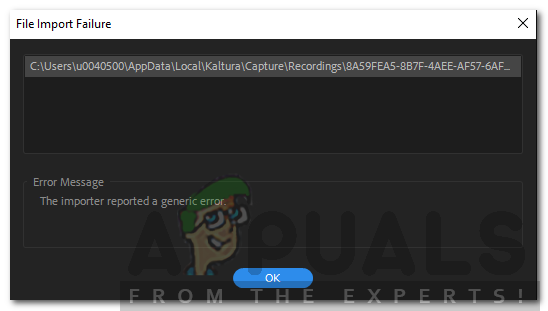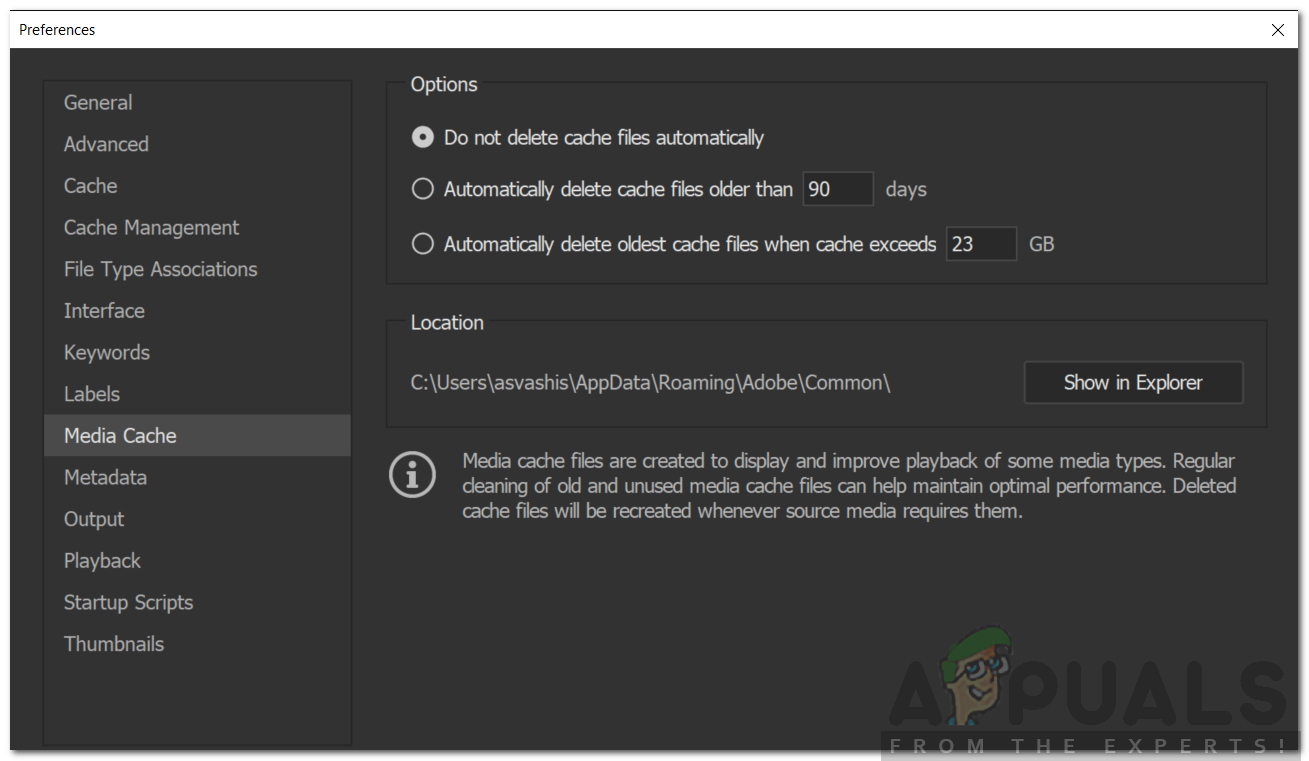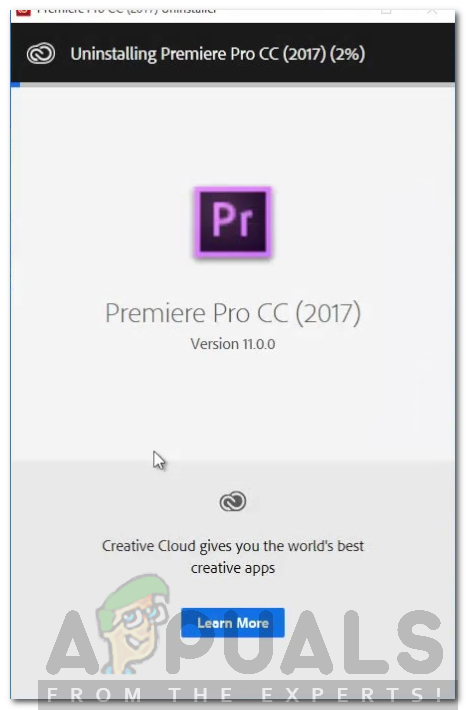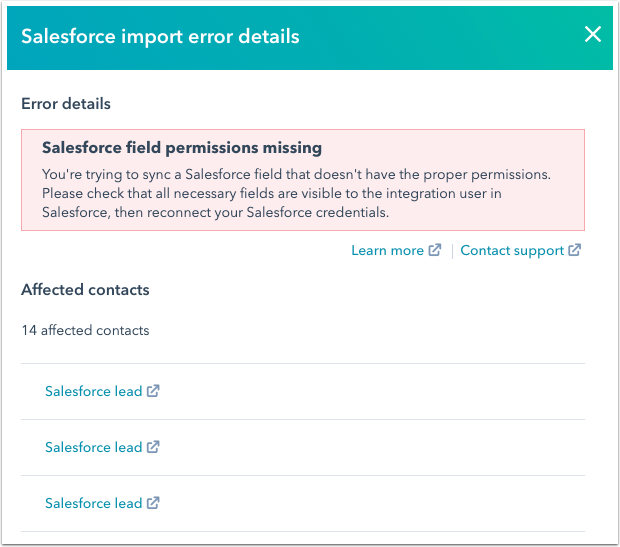- [Исправлено] ImportError: Нет модуля с именем запросов
- 🐌 Что такое «импортеррар» в Python?
- 🐌 Что делает «ImportError»: нет модуля с именем запросов «»?
- ✨ Фиксирование неисправной установки библиотеки запросов
- 📁 исправить путь
- ✨ Как исправить “ImporteRor: Нет модуля с именем запросов” в pycharm
- Заключение
- How to Fix The Importer Reported a Generic Error in Adobe Premiere
- What causes the ‘The Importer Reported a Generic Error’ Error Message in Adobe Premiere?
- Solution 1: Check Video File Format and Codec
- Solution 2: Cleaning the Media File Cache
- Solution 3: Move the Files to a Different Location or Rename Them
- Solution 4: Reinstall Premiere Pro
- Сбой приложения Flask (скорее всего, из-за циклического импорта)
- 2 ответа
- Troubleshoot import errors
- Applies to:
- Download an error file
- Resolve an import file error
- Salesforce import errors
[Исправлено] ImportError: Нет модуля с именем запросов
ImportErRor: Модуль с именем запросов не возникает при попытке импортировать модуль перед его установкой. Вы должны заранее установить его, используя «запросы на установку PIP»
Автор: Shubham Sayon
Дата записи
Проблема разработки: Как исправить ImportError: Нет модуля по имени запросы в Python?
Вы можете работать над веб-проектом Scraping и хотите импортировать библиотеку запросов и проверять состояние ответа. Однако, как только вы пытаетесь выполнить свой код, Python бросает ImportError как показано ниже.
✨ Запросы библиотеки
Запросы это библиотека в Python, которая позволяет вам отправлять Http запросы на сервер. Возвращает Объект ответа который содержит данные ответа, который включает содержимое веб-страницы, состояния, кодирования и т. Д.
🐌 Что такое «импортеррар» в Python?
В Python, Импорт Заявление подает два основных целя:
- Он используется для поиска модуля, указанного по его имени, то загрузите и инициализируйте его, если модуль требуется.
- Это дополнительно определяет имя в локальном пространстве имен в рамках оператора импорта. Это локальное название тогда сможет использовать для ссылки на доступ к доступным модулем по всему коду.
Если оператор импорта испытывает трудности в успешной импорте модуля, он поднимает ImportError Отказ Обычно такая проблема возникает из-за неисправной установки или неверного пути, которая обычно поднимает ModulenotfoundError в Python 3.6 и новые версии Отказ
🐌 Что делает «ImportError»: нет модуля с именем запросов «»?
⚠️ Основные причины возникновения этой ошибки либо « неисправная установка » из Запросы Модуль или попытка импортировать модуль перед его установкой. 📔 Примечание : Поскольку запросы не встроенный модуль, вы Должен Установите его, прежде чем вы сможете использовать его.
⚠️ Также, когда в системе установлена более одной версии Python (E.g. Python 2.x и Python 3.x одновременно). Таким образом, вы могли бы установить пакет в одну из сред, пока вы можете запустить свой скрипт в другой среде.
Теперь, когда мы знаем причину возникновения этой ошибки, давайте погрузимся в решения этой проблемы.
✨ Фиксирование неисправной установки библиотеки запросов
Вы должны убедиться, что вы установили Последняя версия из Запросы Библиотека, использующая следующую команду:
| PIP Установка запросов |
📁 исправить путь
📌 Ошибка может сохраняться даже после установки Запросы библиотека. Это происходит потому, что Пип установлен, но не на пути, который вы можете использовать. Это означает, что в вашей системе установлен PIP, скрипт не может найти его. Следовательно, он не может установить библиотеку, используя PIP в правильном пути.
Чтобы исправить проблему с пути, выполните шаги, приведенные ниже:
- Откройте папку, где вы установили Python. Быстрый способ найти местоположение этой папки:
- Откройте командную строку и введите где Питон
3. Теперь открыть каталог сценариев в командной строке, используя команду CD и местоположение, которое вы скопировали ранее.
4. Теперь установите библиотеку запросов с помощью команды « PIP Установка запросов ».
После последования вышеуказанных шагов выполните наш сценарий еще раз. И вы должны получить желаемый выход.
✨ Как исправить “ImporteRor: Нет модуля с именем запросов” в pycharm
Если вы используете IDE, как Пычарм Тогда жизнь становится легкой, как вы можете устранить ошибку во вспышке, установив правильную версию библиотеки запросов, используя следующие шаги.
- Нажмите на F Иль и выберите S ЭТЫ из раскрывающегося меню.
- Открыть Переводчик Python В диалоговом окне «Настройки».
- Нажмите на значок ➕ в боковом меню. Это открывает диалоговое окно, которое перечисляет доступные пакеты.
- Поиск Запросы Модуль и нажмите на Установить пакет Отказ
Теперь повторно запустите свой код, и он должен дать желаемый выход.
- Вы хотите быстро освоить самые популярные Python IDE?
- Этот курс приведет вас от новичка к эксперту в Пычарме в
90 минут.
Заключение
Я надеюсь, что эта статья помогла вам и ответила на все ваши запросы относительно ImportError в питоне.
Связанная статья: Как исправить “ImporteRor: Нет модуля по имени Pandas”
Пожалуйста, Подписаться нашему Канал и Оставайтесь настроиться Для более интересных Статьи в будущем. Счастливое обучение! 📚
Авторы : 👨🎓 Шубхам Сайон 👩🎓 Rashi Agarwal
Я профессиональный Python Blogger и Content Creator. Я опубликовал многочисленные статьи и создал курсы в течение определенного периода времени. В настоящее время я работаю полный рабочий день, и у меня есть опыт в областях, таких как Python, AWS, DevOps и Networking.
Источник
How to Fix The Importer Reported a Generic Error in Adobe Premiere
Adobe Premiere is one of the leading video editing software. The Adobe Premiere Pro is the successor of Adobe Premiere. The software was first introduced in the year 2003 and soon gained notoriety for its user-friendly interface, features, and potency. Like every other application, it does happen to trouble its users with a few errors now and then. One of them being the ‘The importer reported a generic error’ error message. This appears when you are trying to import videos into the timeline using the importer. This can be due to a lot of reasons, for example, unsupported codec or video file format.

In this article, we will be going through the error message by discussing its causes and later on mentioning the solutions that you can apply to get rid of the error message; thoroughly. Hence, let us start with the causes.
What causes the ‘The Importer Reported a Generic Error’ Error Message in Adobe Premiere?
As we have mentioned earlier, the error message appears while you are using the importer to import video files. This can be due to the following reasons:
- Unsupported Codec: All of the video recording devices use different codecs. In case the codec is not supported by the Adobe Premiere Pro software, you will not be able to import it into the timeline. In such a case, you will have to change the codec of the video files.
- Unsupported Video Files Format: Adobe Premiere is quite generous with the video files format, however, it does not support all of the video files formats for obvious reasons. Therefore, if the video that you are trying to import is not supported by the application, you will, eventually, stumble on the error message.
- Activation Issues: According to Adobe, activation issues can sometimes disrupt some of the functionality of the importer. Therefore, make sure the software is activated and you are logged in your Creative Cloud account.
- Video File Name: In some cases, the issue can also be caused by the name of the video file. There might be some symbols in the name of the file that is causing the issue to pop up.
With that being said, let us get into the real part and help you through this ordeal. Please follow all the solutions provided if one or two of them do not work out for you.
Solution 1: Check Video File Format and Codec
The first thing you should do when you face the error message is to verify that the format the video is in and the codec is supported by Adobe. Certain codecs are not supported by Adobe Premiere, for example, support for the QuickTime codec was dropped by Adobe. In such a case, you will have to transcode the footage to a newer/modern codec.
Similarly, if the video file format is not supported by Adobe, then, you will not be able to import the file. Likewise, you will have to change the format of the video file which is pretty easy. Please refer to this link for a list of supported video file formats.
Solution 2: Cleaning the Media File Cache
Another thing that you can do is try to delete the media files cache and then try to import your files. When you import video or audio files into Adobe Premiere, it stores versions of these files that it can quickly access again for better performance. These stored versions are referred to as Media Cache Files. Here’s how to delete the files:
- Close Adobe Premiere Pro and then navigate to the Users\ \AppData\Roaming\Adobe\Common directory. Please note that the AppData folder is hidden by default, so make sure you have unhid it.
- In case you are using a Mac, please navigate to the /Users//Library/Application Support/Adobe/Commondirectory.
- Delete the files and then launch Adobe Premiere Pro.
- In case you are having difficulties locating the above path, you can also just go to Preferences and then navigate to the Media Cache tab.
Solution 3: Move the Files to a Different Location or Rename Them
In some scenarios, the issue might be due to the specified path of the video or audio files. In such a case, you will have to change the path of the files i.e move them to a different drive or just a different folder. This was reported by many users and has helped them resolve the issue.
You can also try to just simply rename the files in the same directory and then try importing the files. If it doesn’t work, then just move them to a different location.
Solution 4: Reinstall Premiere Pro
If all of the above-mentioned solutions do not work out for you, there might be an issue with the installation of the software and you will have to reinstall it. Here’s how to do it:
- Open up Creative Cloud.
- Uninstall Adobe Premiere Pro while keeping the preferences (an option while uninstalling).
- Once done, install it again and see if it resolves the issue.
Источник
Сбой приложения Flask (скорее всего, из-за циклического импорта)
Я следовал этому руководству здесь: https://youtu.be/mISFEwojJmE?t=367. Это очень простое приложение Flask для создания страниц входа и регистрации пользователей на сайте. До этого момента в руководстве все работает: при импорте объектов среди скриптов в моем проекте я получаю эту ошибку.
Вместо того, чтобы опубликовать свое собственное приложение, я вернулся и просто продублировал его приложение до этого момента в руководстве, которое работает на его Mac. Но выдает ту же ошибку, что и мое фактическое приложение, работающее на моем компьютере. Я также попытался использовать свой env как из VS Code, так и из командной строки в качестве администратора. Вот он:
Структура файла
Примечание. Файл init .py пуст.
2 ответа
Сообщение об ошибке cannot import name ‘app’ from partially initialized module ‘app’ говорит о том, что по мере того, как Python компилирует один файл, ему необходимо скомпилировать другой — модуль для импорта. Однако этот второй файл также требует чтения импорта, который является исходным первым файлом. Итак, python не может скомпилировать один без компиляции другого.
Лучшее решение — просто импортировать app.routes в конец файла app.py, например:
Это должно решить проблему.
Держите from app import app вверху файла routes.py. Имейте в виду, что отсутствие init .py в каталоге вашего приложения может привести к трудностям при импорте.
Как ранее говорил Янакин, оператор импорта не обязательно должен быть в конце файла. Вместо этого его можно разместить в любой момент после инициализации app :
Источник
Troubleshoot import errors
Last updated: September 10, 2021
Applies to:
When importing records into HubSpot, you may encounter errors. Below, learn how to download an error file, view error details, and correct issues in your import file or Salesforce.
Before starting an import or fixing a file with errors, learn the relevant terms and requirements for importing into HubSpot.
Download an error file
- Navigate to your records:
- Contacts: In your HubSpot account, navigate to Contacts >Contacts.
- Companies: In your HubSpot account, navigate to Contacts >Companies.
- Deals: In your HubSpot account, navigate to Sales >Deals.
- Tickets: In your HubSpot account, navigate to Service >Tickets.
- Custom objects: In your HubSpot account, navigate to Contacts > Contacts, then click the dropdown menu in the top left and select the name of the custom object.
- In the upper right, click Import.
- Hover over a file import with errors and click the More dropdown menu, then select Download error file.
- Extract the CSV file from the downloaded zip file, then open the CSV file.
- In the file, identify the error code under the Error code header, the affected object under Object type, the reason for the error under Reason, and the details of the object with the error in the subsequent columns.
Resolve an import file error
The following is an alphabetized list of error codes with details for the error and possible steps for resolution. In some cases, records with errors will be imported and can be corrected either in HubSpot, or by correcting the import file and reimporting. In other cases, records will not import and the import file will need to be corrected before reimporting.
Please note: the error codes in your file will contain capital letters and underscore characters, but are listed in normal text within this article. For example, the error will appear as AMBIGUOUS_ENUMERATION_OPTION in the file, but you will find it as Ambiguous enumeration option in the table below.
| Error code | What the error means | Steps to resolve the error |






